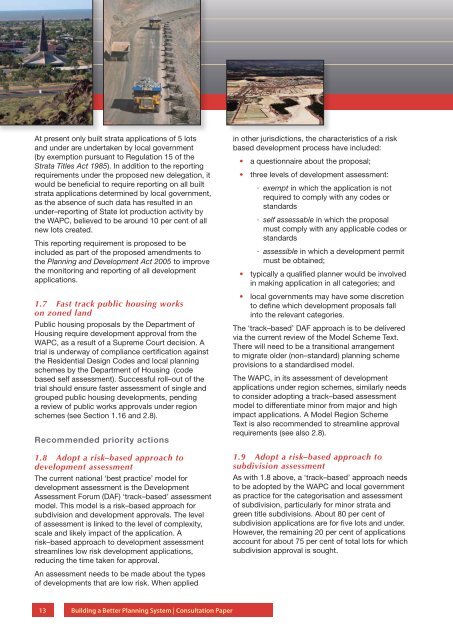Building a Better Planning System - Western Australian Planning ...
Building a Better Planning System - Western Australian Planning ...
Building a Better Planning System - Western Australian Planning ...
You also want an ePaper? Increase the reach of your titles
YUMPU automatically turns print PDFs into web optimized ePapers that Google loves.
At present only built strata applications of 5 lots<br />
and under are undertaken by local government<br />
(by exemption pursuant to Regulation 15 of the<br />
Strata Titles Act 1985). In addition to the reporting<br />
requirements under the proposed new delegation, it<br />
would be beneficial to require reporting on all built<br />
strata applications determined by local government,<br />
as the absence of such data has resulted in an<br />
under–reporting of State lot production activity by<br />
the WAPC, believed to be around 10 per cent of all<br />
new lots created.<br />
This reporting requirement is proposed to be<br />
included as part of the proposed amendments to<br />
the <strong>Planning</strong> and Development Act 2005 to improve<br />
the monitoring and reporting of all development<br />
applications.<br />
1.7 Fast track public housing works<br />
on zoned land<br />
Public housing proposals by the Department of<br />
Housing require development approval from the<br />
WAPC, as a result of a Supreme Court decision. A<br />
trial is underway of compliance certification against<br />
the Residential Design Codes and local planning<br />
schemes by the Department of Housing (code<br />
based self assessment). Successful roll–out of the<br />
trial should ensure faster assessment of single and<br />
grouped public housing developments, pending<br />
a review of public works approvals under region<br />
schemes (see Section 1.16 and 2.8).<br />
Recommended priority actions<br />
1.8 Adopt a risk–based approach to<br />
development assessment<br />
The current national ‘best practice’ model for<br />
development assessment is the Development<br />
Assessment Forum (DAF) ‘track–based’ assessment<br />
model. This model is a risk–based approach for<br />
subdivision and development approvals. The level<br />
of assessment is linked to the level of complexity,<br />
scale and likely impact of the application. A<br />
risk–based approach to development assessment<br />
streamlines low risk development applications,<br />
reducing the time taken for approval.<br />
An assessment needs to be made about the types<br />
of developments that are low risk. When applied<br />
in other jurisdictions, the characteristics of a risk<br />
based development process have included:<br />
• a questionnaire about the proposal;<br />
• three levels of development assessment:<br />
••<br />
exempt in which the application is not<br />
required to comply with any codes or<br />
standards<br />
••<br />
self assessable in which the proposal<br />
must comply with any applicable codes or<br />
standards<br />
••<br />
assessible in which a development permit<br />
must be obtained;<br />
• typically a qualified planner would be involved<br />
in making application in all categories; and<br />
• local governments may have some discretion<br />
to define which development proposals fall<br />
into the relevant categories.<br />
The ‘track–based’ DAF approach is to be delivered<br />
via the current review of the Model Scheme Text.<br />
There will need to be a transitional arrangement<br />
to migrate older (non–standard) planning scheme<br />
provisions to a standardised model.<br />
The WAPC, in its assessment of development<br />
applications under region schemes, similarly needs<br />
to consider adopting a track–based assessment<br />
model to differentiate minor from major and high<br />
impact applications. A Model Region Scheme<br />
Text is also recommended to streamline approval<br />
requirements (see also 2.8).<br />
1.9 Adopt a risk–based approach to<br />
subdivision assessment<br />
As with 1.8 above, a ‘track–based’ approach needs<br />
to be adopted by the WAPC and local government<br />
as practice for the categorisation and assessment<br />
of subdivision, particularly for minor strata and<br />
green title subdivisions. About 80 per cent of<br />
subdivision applications are for five lots and under.<br />
However, the remaining 20 per cent of applications<br />
account for about 75 per cent of total lots for which<br />
subdivision approval is sought.<br />
13<br />
<strong>Building</strong> a <strong>Better</strong> <strong>Planning</strong> <strong>System</strong> | Consultation Paper

















